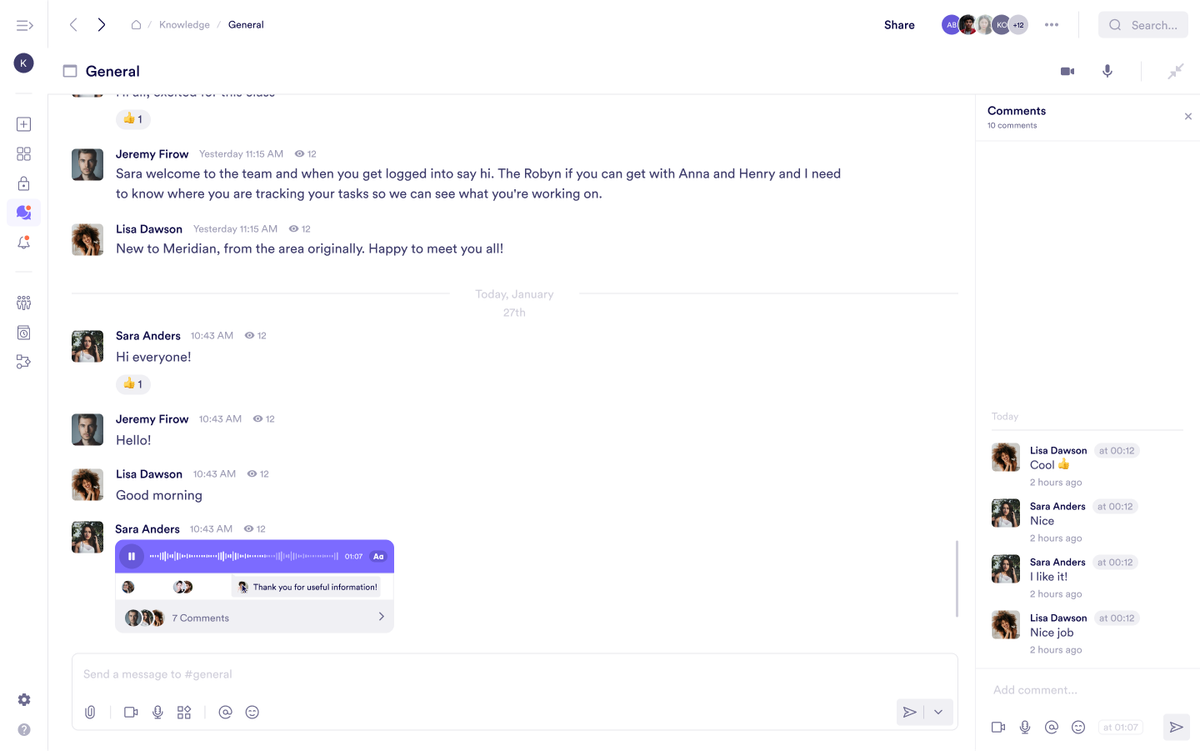Feb 6, 2025
Chat Apps Are Holding Teams Back—Here’s a Better Way
 Jennifer Simonazzi
Jennifer Simonazzi
The workday starts, and your team is already buried in a wave of notifications. Conversations overlap, tasks are lost in endless threads, and every update feels like it’s interrupting something else. Team effort is there, but it can easily be drowned out by the noise.
Many workplace chat apps were built for quick exchanges but leave behind a trail of confusion and fragmented progress. Messages get buried, important updates are missed, and juggling communication across channels becomes exhausting.
What teams need isn’t more features to sift through but a balanced way to collaborate. Real-time chats, asynchronous updates, and context-driven communication can reduce chaos and create space for meaningful work. Effective communication propels your projects forward; it shouldn’t stand in their way. Let’s take a closer look at why your current setup might not be cutting it.
The Everyday Struggles of Relying on Chat Apps Alone
Chat apps promise convenience but often deliver chaos. Notifications pour in, pulling your team in every direction. Important updates drown in endless threads, leaving you sifting through conversations to find what matters.
Picture this: a project deadline is looming. Half your team is caught up responding to pings, while others miss key messages buried in a flood of unrelated chats. Updates are scattered across channels, and vital decisions feel like whispers lost in the commotion.
Beyond the disruption, these platforms often fail to fit the way your team works. They isolate communication from task management or lack the flexibility to adapt to your workflows. The result? Teams waste time piecing together disconnected processes instead of focusing on progress.
When team chat tools hinder collaboration, the impact spreads far and wide:
- Progress slows as key updates are buried.
- Priorities blur with scattered conversations.
- Motivation fades when work feels fragmented.
It’s time to rethink how workplace chat should truly work.

What Teams Really Need in a Workplace Chat App
Teams don’t just need a way to talk; they need a system that enhances how they work together. Communication should feel purposeful, whether it’s a quick update, a focused discussion, or a brainstorming session that sparks something bigger.
A workplace chat app should offer flexibility. Some conversations demand immediate attention through live chats or calls, while others benefit from asynchronous updates, like posts or recorded messages. Teams should have the freedom to work at their own rhythm without feeling rushed or out of sync.
When planning a campaign, for example:
- Quick updates can be logged in posts for easy reference.
- Decisions can be clarified in a group call, reducing misunderstandings.
- Follow-ups can happen asynchronously, ensuring no detail is overlooked.
For this to work as it should, communication must be intuitively connected to tasks and projects, ensuring nothing gets lost. An effective chat app adapts to the team’s needs, offering structure without rigidity and enabling collaboration where every interaction adds value to the work at hand.
The Pivot Way: Say It, Save It, and Act on It
Most team chat apps weren’t built for the way teams actually work. They keep conversations flowing but rarely connect them to what comes next.
Pivot shifts the focus from just keeping teams in touch to helping them move forward. Conversations don’t sit in isolation; they live alongside projects, tasks, and shared content, making it easier to turn ideas into outcomes.
- A quick chat can lead to a structured post.
- A voice message can capture key takeaways without losing details.
- A team-wide announcement can happen live, without switching platforms.
Instead of treating communication as a separate task, Pivot builds it into the way work naturally happens. Fewer interruptions, more focus, and a system that keeps every exchange connected to the bigger picture.

Why Pivot Outshines Slack and Microsoft Teams for Team Communication
Slack and Microsoft Teams often fall short of providing the balance teams need between communication and action. With Slack, conversations quickly become chaotic, buried under endless threads. Microsoft Teams, while structured, can feel overly rigid and disconnected from the workflows teams rely on to get work done.
Pivot offers a fresh Slack alternative and Microsoft Teams alternative, designed to reduce frustration and bring communication closer to your projects.
Here’s how Pivot stands out:
- Versatile rooms: Combine chat, audio, video, posts, and streaming in one environment. Unlike Slack, where updates often get lost in fragmented threads, Rooms ensure discussions stay focused and connected.
- Workflow integration: While Teams might structure communication, it often feels cumbersome when switching between calls, messages, and project tools. Pivot keeps everything in sync, so teams can move from a quick chat to a video discussion or livestream without losing context.
- Connected spaces: Spaces in Pivot aren’t just places to talk—they connect communication to your team’s work. Files, tasks, and updates live alongside discussions, so there’s no need to toggle between apps.
- Streaming capabilities: Host live presentations or team-wide updates directly in Pivot. Paired with asynchronous options like posts or recorded messages, Pivot ensures teams have flexibility in how they collaborate.
Unlike other chat apps that require endless integrations, Pivot keeps everything connected from the start.
Take Control of Communication with Pivot
Communication must make teamwork smoother and more purposeful; if they don’t, they fail their purpose. Pivot helps teams go beyond the limits of Slack and Microsoft Teams by blending messaging, project collaboration, and real-time discussions into a single, adaptable platform. Say goodbye to missed updates, disjointed workflows, and endless app toggling.
Ready to see the difference? Explore how Pivot brings communication and teamwork together to help your projects bloom HERE.

Jennifer Simonazzi
Content Writer
Share this post
